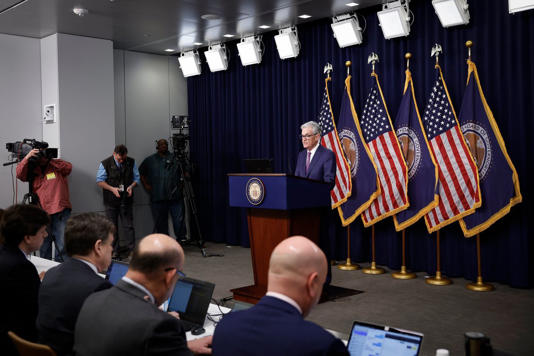
The strongest U.S. jobs report in a year has dented investors’ hopes that the Federal Reserve will drastically slash interest rates this year, the latest reversal for those betting the economy is on track to achieve a soft landing.
Data out Friday showed that workers’ wages are rising much faster than economists anticipated, and there are few signs of an economic slowdown. Earlier last week, Fed Chair Jerome Powell said a rate cut in March was unlikely, disappointing those who had bet cuts were imminent. Bond prices, which had been shored up by the rate-cut expectations, tumbled, sending the 10-year Treasury yield to 4.030% Friday from as low as 3.815% on Thursday. Friday’s rise was the 10-year yield’s largest since September 2022.
Traders are now betting the benchmark federal-funds rate will finish the year around 4.2%. Just a couple of weeks ago, they wagered it would be below 3.9%. Though U.S. stock indexes have had a robust start to the year, with the Dow Jones Industrial Average up 2.6% and the Nasdaq Composite up 4.1%, many analysts and portfolio managers worry that further stock advances could be halting if this year’s favorable interest-rate scenario doesn’t materialize.
“If more people are working and they’re getting paid more, that doesn’t present a great argument for rate cuts,” said Steve Sosnick, chief strategist at Interactive Brokers.
At the same time, investors remain alert to any signs that more market unrest could lie ahead, and any development that threatens such turmoil tends—as it almost always has—to boost demand for ultrasafe Treasurys and push yields back down.
Some sectors are feeling the pinch from the highest interest rates in 22 years. Regional bank tremors reignited a rally in U.S. debt earlier in the past week, reflecting in part fears that an economic expansion that has surprised many observers with its persistence could be vulnerable to reduced lending.
New York Community Bancorp, which took over assets of failed Signature Bank last year, fell 42% last week after reporting dismal fourth-quarter results. That dragged a KBW index of regional banks 7.2% lower, its worst week since June.
“The market is conditioned to react whenever there’s trouble in the banking system,” said Joseph Wang, chief investment officer at Monetary Macro and a former senior trader at the New York Fed.
During SVB’s collapse last March, investors piled into Treasurys, as they often do at signs of turmoil regardless of the origin. Investors’ impulse to scoop up bonds at the sign of banking-system trouble clearly remains. What looked to be a one-off concern for a troubled bank percolated across the sector last week when shares of several global banks sank because of a deterioration of their loan books.
“Bonds are back because they’re a hedge against things breaking,” said Anwiti Bahuguna, chief investment officer of global asset allocation at Northern Trust Asset Management.
Investors had some policy updates to contend with as well. Powell said officials would discuss a slowdown of its balance-sheet runoff at the March meeting, though some analysts anticipated that so-called tapering would begin sooner. Such a development potentially could boost the Treasury market by decreasing the amount of debt the government needs to issue.
Wall Street was eager to learn about the government’s borrowing plans on Wednesday, particularly after the previous two quarterly announcements fueled big moves in the bond market. The Treasury Department mostly met investors’ expectations, gradually raising the size of long-term debt sales in coming months. The government also said it was unlikely to raise auction sizes in ensuing quarters, quelling some issuance-related fears that yields could climb higher.
Some economic data supported bond prices early last week. A Labor Department proxy for layoffs rose to the highest level since mid-November. Powell also commented on the Employment Cost Index, which rose in the fourth quarter by its smallest amount since 2021. A gradual cooling of the labor market supports the Fed’s taming of inflation—but Friday’s nonfarm payrolls number counteracted those prints.
“There continues to be mixed signals, that’s been the theme for the last 12 months or longer,” said Anders Persson, Nuveen’s chief investment officer for global fixed income. “There’s a little bit for everyone—whether you think the Fed will be hawkish or dovish, there’s data to support your narrative.”
Last week highlights the difficulty investors are facing in forecasting the path of policy. Markets are still at risk of the economy’s being too strong to fuel the six or so interest-rate cuts that traders anticipated for months. Falling rates tend to boost share prices by lifting economic growth and reducing the competition from bonds for investor dollars.
For now growth—and the stock market—are charting higher. An Atlanta Fed model is showing inflation-adjusted growth as likely to come in at 4.2% in the first quarter. The latest Conference Board survey shows consumers haven’t been this optimistic since 2021.
Some investors think resilient growth means there is a risk that inflation won’t subside to levels where the Fed can claim victory.
“The data is still supportive of strong consumer spending, employment, government spending—all things that keep the economy humming along,” said Andy Constan, chief executive of Damped Spring Advisors, a consulting firm for macro hedge funds. “The question is whether inflation stabilizes at too-high a level. I suspect it will.”
Write to Eric Wallerstein at eric.wallerstein@wsj.com
Source: The Wall Street Journal






